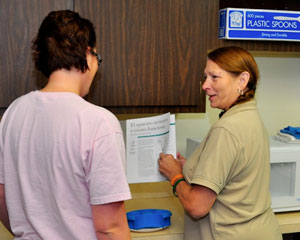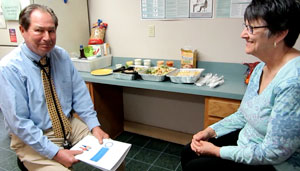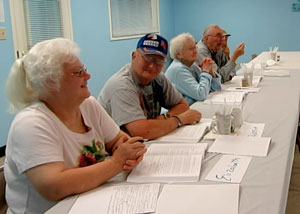Aug 20, 2014
Diabetes Management in Rural Areas Takes Holistic, Community Approaches

Carol B. has lost more than 100 pounds and cut her blood sugar averages in half since being diagnosed with Type 2 diabetes. But, she says, her disease is almost impossible to effectively control, so she is grateful for the professional assistance she receives from Heartland Rural Health Network (HRHN) in Avon, Fla.
“I've made 180 degree changes in the way I cook and eat,” Carol said. “I've upped my exercise. I've learned better how to do my medication. But it's a daily battle and what affects me negatively one time won't bother me another time. When my doctor suggested referring me to Heartland, I told him I would love having any help that could give me insight. And they even come to my house.”
Uncontrolled diabetes leads to serious and costly complications such as heart disease, stroke, blindness, kidney failure and lower limb amputations. HRHN's diabetes program and Kentucky's KIPDA Rural Diabetes Coalition (KRDC) are among federally funded grant programs with the purpose of helping people prevent development of diabetes and helping already diagnosed diabetics help themselves.
“People who are able to effectively control their diabetes over time have fewer strokes, fewer hospitalizations and less blindness and kidney failure,” asserts Dr. Ed Shahady, a co-founder and current medical director of the Diabetes Master Clinician Program (DMCP). “Diabetes is not taken care of in a one-time office visit. It requires an ongoing relationship between providers and their patients. There is excellent, evidence-based data that shows if you get patients' A1C under control, their chances of going blind are minimal. And when you don't, their chances of kidney failure get higher.”
Shahady reported in Clinical Diabetes that DMCP has helped its patients attain better control of their diabetes while offering them significant cost savings. The American Diabetes Association (ADA) sets control goals related to lowering A1C, cholesterol and blood pressure levels. DMCP's free services for providers include a web-based diabetes registry, in conjunction with education and networking support for physicians. DMCP currently has 23,466 patients and 138,487 visits in its registry. Initiated by the Florida Academy of Family Physicians, DMCP is supported primarily by grants and donations, serving provider practices in Florida, Georgia, Oklahoma, Missouri, Illinois and North Carolina. Seventy percent of members are in rural locations. Shahady said DMCP is also expanding its relationship with physician practices in additional states.
Diabetes Higher among Rural and Minority Populations
The incidence of diabetes is about 17 percent higher in rural areas and racial and ethnic minorities are also at higher risk of developing the disease, according to Rural Healthy People 2020 (RHP) Co-author Jane Bolin, director of Texas A&M's Southwest Rural Health Research Center in College Station, Tex. Bolin said rural populations and some minority populations are also affected by diabetes complications to a greater degree, such as having higher rates of lower limb amputations, cardiovascular disease, renal failure, and blindness.
“Studies examining access to diabetes education have shown that it is more difficult for minority groups to find culturally appropriate education,” Bolin said. “We've seen that diabetes-related lower limb amputations are higher among Hispanics, and it is not clear whether this is related to lack of education (checking their feet), or whether it is because they are more likely to be uninsured with no regular primary care doctor.”
Anecdotally, Bolin and her study team have learned that many young Hispanics just expect to get diabetes because their parents and grandparents did. Changing cultural habits, such as tortillas at every meal, is difficult. They don't understand that learning to make good choices and changing diet can help them avoid getting diabetes. They may not know the status of their blood sugar, A1c or urine albumin because they don't have access to regular medical care.
According to The Disparate Impact of Diabetes on Racial/Ethnic Minority Populations, Hispanics, American Indians, Alaska Natives, Black or African Americans, Asian Americans, Native Hawaiians and other Pacific Islanders have a higher prevalence of Type 2 diabetes. Some minority groups also have higher rates of complications.
Home Management Bridges Rural Gaps
HRHN Executive Director Kelly Johnson says their diabetes program helps bridge the gaps in a region where there are long distances between healthcare facilities, no public transportation and large populations of elderly, low-income residents that often have no personal transportation. While there is little data establishing reasons for the higher diabetes rates among rural populations, the situation Johnson cites is common in many rural areas and negatively impacts patient access.
Community Health Workers (CHWs) who live in communities where they work are HRHN's key link between clients and providers. CHWs see patients in their home to assess and assist them with home management practices, and confer regularly with providers about the patients.
“Karen is a huge support for me,” Carol said of her CHW, Karen Nutter. “I don't know what I'd do without her. She really helps me understand what I can do to improve my heath and to set goals I can achieve.”
HRHN's affiliation with DMCP strengthens HRHN's services. Patients and providers alike appreciate DMCP's report card for members, said HRHN Program Coordinator Melissa Thibodeau. Clients receive concrete, understandable information on their medical status and progress. Providers get an immediate snapshot of the patient's current condition without having to consult multiple laboratory reports.
“The report card also helps us make sure diabetic patients are up-to-date on things that fall through the cracks, like eye exams and foot checks,” Thibodeau said.
HRHN's diabetes prevention efforts include a six-week nutritional program, Healthy Eating for Successful Living in Older Adults, which is so popular it has a waiting list and an impressive 87 percent completion rate among participants.
More than 1,500 clients have been referred to HRHN's diabetes program, which was added in 2008 with funding from a Health Resources and Services Administration (HRSA) Rural Health Network Development Grant. A current HRSA Outreach Grant has helped expand the reach of the DMCP. A nonprofit agency, HRHN serves Highland and Hardee counties.
Working to Change Community Culture in Kentucky

KRDC formed four years ago to address needs of diabetics in Bullitt, Henry, and Shelby counties, three heavily rural regions where diabetes, obesity and smoking rates are all higher than national averages. All three counties are designated as food deserts, and two are designated as Health Care Provider Shortage areas. Tobacco is a primary crop and local officials have been reluctant to embrace smoking bans.
Despite their formidable challenges, Project Manager Teresa McGeeney says, “We have made a lot of progress and it's been rewarding to see attitudes change and community members buy into what we are doing.”
Projects like PhotoVoice raised community awareness and built community trust and ownership, McGeeney said. KRDC equipped diabetics with disposable cameras to document community-specific environmental challenges to a healthy lifestyle. The photo display included empty produce sections in grocery stores, high-priced food stickers and walking hazards.
“It helped communities understand the problems from the perspective of people living with the disease and it made an impact because these are their friends and neighbors,” McGeeney said. “Some good things came out of it. One man contacted local officials about his picture of a broken sidewalk. We were able to work with him and them to get the sidewalk repaired.”

KRDC's efforts to help people with diabetes better manage their disease include implementation of the Stanford Diabetes Self-Management Course, diabetes support groups, peer mentoring and health provider continuing education. Community participation continues to increase for KRDC's community awareness events and its Facebook and blog sites.
“I would say our biggest success is a sustainable Coalition that works toward addressing systematic and environmental challenges to health,” McGeeney asserted. “What's most rewarding is to see community members come together to work toward addressing barriers to health in their communities. Our Coalition members know their local officials, and even have been to the state capitol to advocate for diabetes. This year, they participated in a successful advocacy effort to designate $2.6 million in the state budget to go toward diabetes efforts.”
Coalition members meet monthly to plan and measure progress, and then work independently with volunteers in their counties to implement strategies and programs. The Kentuckiana Regional Planning and Development Agency (KIPDA) and the University of Louisville Kent School of Social Work provide support to the Coalition. KRDC's program is supported by a five-year grant from the CDC National Program to Eliminate Diabetes-Related Disparities in Vulnerable Populations. KRDC program success, including measurable changes in diabetics' health, will be evaluated in 2015.
Diabetes Care Models Require Big Picture Approach
Diabetes education and prevention efforts have been steadily increasing over the past decade. However, diagnosed cases of diabetes continue to rise. Bolin said some experts attribute increased diagnoses to increased awareness.
While diabetes ranks second among RHP 2020 health concerns, Bolin noted that access is the top concern and obesity came in a close third to diabetes. All are interrelated.
“Obesity is a major factor in diabetes development and limited access to health care negatively impacts diagnoses and care,” Bolin said. “If you treat weight gain and obesity, you go a long way toward preventing or treating diabetes. If you treat diabetes, you go a long way toward preventing or treating cardiovascular disease. Improved nutrition goes a long way toward preventing chronic disease. Poor nutrition is primarily a matter of lack of education. In rural areas, access to healthy, affordable foods is also limited. All of these things go hand in hand. To be successful, health care models need to also address the root causes of chronic disease.”
Preventative care is the first step, Shahady concurred. “If we offer preventative care, people with diabetes live healthier and enjoy life more. And the healthcare industry saves money doing it.”
Sidebar: Diabetes: A Closer Look
Back to: Summer 2014 Issue
